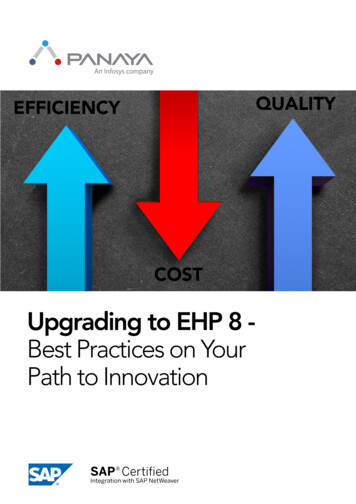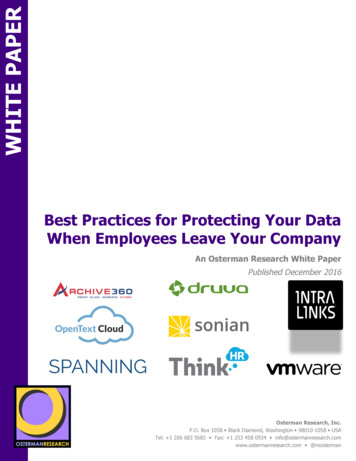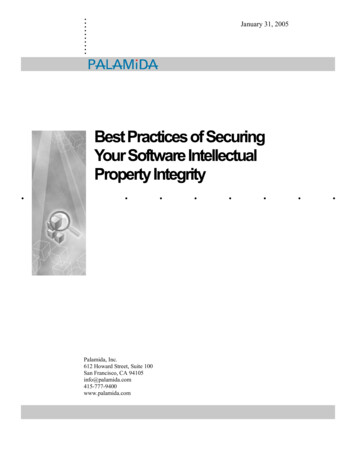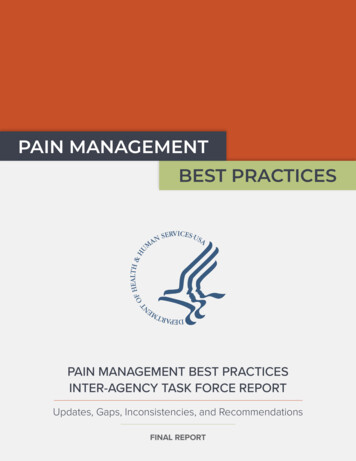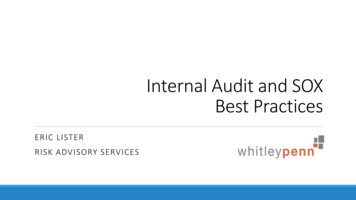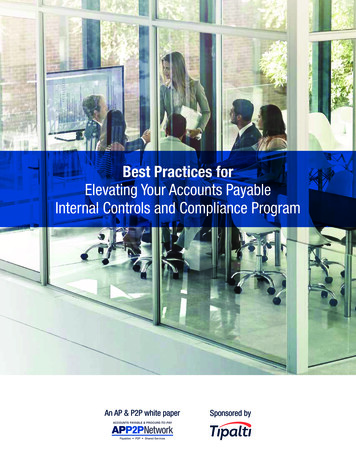
Transcription
Best Practices forElevating Your Accounts PayableInternal Controls and Compliance ProgramAn AP & P2P white paperSponsored by
TABLE OF CONTENTSIntroduction .3What are the Roles of the CFO and Controller? .4Who is Responsible for Financial Complianceand Internal Controls? .4The Three Critical Corporate Controls to AchieveBest-in-Class AP Compliance .4The Supplier Onboarding Process .6Detecting and Preventing Accounts Payable Fraud .8Managing the Risk: Internal Control Process forthe Accounts Payable Record to Report (R2R) Process .9Addendum 1: Summary of Best Practices .11Addendum 2: Comprehensive Compliance Guide .122
Best Practices forElevating Your Accounts Payable Internal Controls and Compliance ProgramIntroductionThe AP Department plays a critical role within an organization. As a governing entity in the supplier sourcing process,it ensures that each supplier is properly screened prior to onboarding, thereby protecting the company from risk dueto fraud, fines, audits, and investigations. Once a supplier relationship is established, the AP Department continuesto protect the company’s financial interests by ensuring timely invoice processing, verifying that payments are madeaccording to agreed-upon terms, and providing a high level of customer service.Last but not least, accounts payable also serves as the last point of control before a payment is sent to a supplier.Once money is sent to a supplier, your chances of retrieving these funds at a later date due to an unintended data entryerror or due to fraud by an employee or supplier are extremely low. The right approval workflows, signatory rights, andprocesses must be proactively established to minimize the likelihood of this occurring.AP also supports the integrity of the supplier master file within the Procure to Pay (P2P) process and the integrity of thefinancial transaction through the financial close or the Record to Report (R2R) process. Error-prone and delayed paymentreconciliation processes raise red flags that can lead to financial reporting errors and audits.Given their crucial role in the business, accounts payable processes are subject to compliance requirements andinternal controls that can be complicated and overwhelming. Companies that operationalize best practices into their APprocesses and monitor them with internal control systems can manage the complexity, prevent transactional or closingproblems, and consistently maintain the integrity of their corporate transactions.This whitepaper will put you on a path to establish a best-in-class compliance and internal controls program for your APDepartment. It includes requirements and recommended best practices, along with roles and responsibilities for theirimplementation. 2016 IOFM, Diversified Communications. No part of this publication may be reproduced,stored inin aa retrievalretrieval systemsystem oror transmittedtransmitted byby anyany means,means, electronicelectronic oror mechanical,mechanical, withoutwithout priorpriorstoredwritten permissionpermission ofof thethe InstituteInstitute ofof FinanceFinance && Management.Management.written3
Best Practices forElevating Your Accounts Payable Internal Controls and Compliance ProgramWhat are the Roles of the CFO and Controller?The CFO and Controller play four vital roles in establishing a compliance and internal controls program. They are:Stewards: CFOs and Controllers protect and preserve the assets of the organization by establishing strong controls,complying with regulations, and preventing risks.Operators: They balance capabilities, costs, and service levels to fulfill the finance organization's responsibilitiesin a controlled environment.Strategists: They provide financial leadership in determining strategic business direction and align financial strategieswith minimal risk.Catalysts: They stimulate behaviors across the organization to achieve strategic and financial objectives withstrong controls.Who is Responsible for Financial Compliance and Internal Controls?A company’s emphasis on internal financial control and compliance starts with its “tone at the top,” the ethicalatmosphere that is created in the workplace by the organization's leadership. The tone set by management has atrickle-down effect on both the employees and suppliers of the company. If managers emphasize ethics and integrity,employees and suppliers will be more inclined to uphold the same values.The Best Practice (1 of 7):Integrate ethics and compliance requirements into all business processes to ensure that the “tone at the top”is embedded throughout the organization. Specifically as it relates to accounts payable financial controls, fraudprevention, and tax and regulatory compliance, the office of the CFO is responsible for establishing these guardrailsand expectations for that function. This approach establishes a corporate environment of internal controls andcompliance that extends to the accounts payable organization, including supplier management. These initiativestypically include the deployment of ethical standards or a code of conduct for the organization. This is also arequirement for Sarbanes Oxley 404.Who is Responsible: Financial Executive Staff and Ethics Officer for implementation and all CompanyEmployees for adherence.The Three Critical Corporate Controls to Achieve Best-in-Class AP ComplianceThere are three critical corporate controls (a.k.a. “core controls”):1. Segregation of Duties (SoD)2. Systems Access (SA)3. Delegation of Authority (DoA)The Segregation of Duties (SoD)The Segregation of Duties (SoD) control is one of the most important controls that your company can have. Adequatesegregation of duties reduces the likelihood that errors (intentional or unintentional) will remain undetected by providingfor separate processing by different individuals at various stages of a transaction and for independent reviews of thework performed. 2016 IOFM, Diversified Communications. No part of this publication may be reproduced,stored inin aa retrievalretrieval systemsystem oror transmittedtransmitted byby anyany means,means, electronicelectronic oror mechanical,mechanical, withoutwithout priorpriorstoredwritten permissionpermission ofof thethe InstituteInstitute ofof FinanceFinance && Management.Management.written4
Best Practices forElevating Your Accounts Payable Internal Controls and Compliance ProgramThe SoD control provides four primary benefits:1. the risk of a deliberate fraud is mitigated as the collusion of two or more persons would be required inorder to circumvent controls2. the risk of legitimate errors is mitigated as the likelihood of detection is increased3. the cost of corrective actions is mitigated as errors are generally detected relatively earlier in their lifecycle4. the organization’s reputation for integrity and quality is enhanced through a system of checks and balances.Although SoD is a basic key internal control, its often one of the most difficult to accomplish due to limited headcount,broadly defined responsibilities, and constantly changing responsibilities. Basically, the general duties to be segregatedare: planning/initiation, authorization, custody of assets, and recording or reporting of transactions.Additionally, control tasks such as review, audit, and reconcile should not be performed by the same individualresponsible for recording or reporting the transaction.Best Practice (2 of 7):One of the most common “root causes” of fraud is the lack of SoD controls, weak SoD controls, inappropriatecompensating controls, or failure to update SoD controls when responsibilities change. As a best practice, manyorganizations review their SoD controls on a quarterly basis as part of their control self-assessment (CSA) process.As a result of this review, the applicable SoD controls are updated appropriately.Systems AccessSystems automation can play a crucial role in establishing, simplifying, and monitoring all three of the core controls,particularly role-based system access and activity logging. Many companies experience lapses in control due to theirreliance on manual processes, or experience vulnerabilities in the transfer of data from one system to another. Humanbeings make mistakes, but a system of checks and balances can mitigate the risk of fraud or mismanagement.The Best Practice (3 of 7):Employ systems that provide flexibility and discrete configuration of controls around system access and criticalaccounts payable paths. Specifically, certain employees should have full ability to effect AP transactions, approvalrights, and access to information, while some may only be able to affect certain processes, have “read only” visibilityor only limited visibility. On a related note, account funding for supplier payments should have limited access andclear roles. This reduces the need to manually monitor every transaction.Who is Responsible: Controller and Accounts PayableDelegation of AuthorityIn an automated Delegation of Authority (DoA) process, supplier onboarding, invoice and payments approval are alllinked to the company’s DoA Policy and the employee Master file and is automated based on defined workflow rules.The workflow determines: (1) if a supplier / invoice / payment needs approval; (2) who the appropriate approversare, and; (3) in what order payments should be approved according to established company rules. The workflow willthen sequentially ask each approver via a generated email to electronically approve invoices and also payments. (Forexample, you can define a rule so that invoices over a certain threshold require CFO approval and then CEO approval.) 2016 IOFM, Diversified Communications. No part of this publication may be reproduced,stored inin aa retrievalretrieval systemsystem oror transmittedtransmitted byby anyany means,means, electronicelectronic oror mechanical,mechanical, withoutwithout priorpriorstoredwritten permissionpermission ofof thethe InstituteInstitute ofof FinanceFinance && Management.Management.written5
Best Practices forElevating Your Accounts Payable Internal Controls and Compliance ProgramThe Best Practice (4 of 7):Leading-practice companies link the DoA policy to the job levels within the employee master file. They then establisha DoA table to drive the approval workflow. If an approver moves to a different position or department or leaves thecompany, the approval tables are automatically updated.Who is Responsible: Controller, Accounts Payable, and ProcurementThe Supplier Onboarding ProcessSupplier Data CollectionThe supplier onboarding process involves validating the supplier and ensuring that there are no financial or compliancerisks before adding them to the master file. This process requires appropriate and continuously enforced segregationof duties. Not enforcing a proper supplier data validation process exposes your company to potential fraud, supplierpayment error fees and delays, tax compliance issues, and other regulatory problems. If your company pays suppliersoutside of the US, the rules and requirements for data validation increase dramatically with thousands of differentvariations to check up against.Ownership of the process usually resides in the accounts payable organization; however, some companies split theoverall responsibility between the procurement and accounts payable departments.In such cases, procurement may set up the supplier, but accounts payable is responsible for any changes made tothe supplier master file. In most cases, accounts payable owns supplier payment and tax information collection andvalidation.Lastly, many large Fortune 100 companies have established Shared Services Centers wherein the finance team takesresponsibility for all master files, including the supplier master, the material master, and the customer master. This is anexcellent way to avoid any potential segregation of duties issues.The Best Practice (5 of 7): Validate supplier contact information, payment data, and tax information prior to supplier approval. Thisprocess should take into account the different requirements per each payment method and payee country. Employ TIN matching to ensure verification of supplied vendor data. TIN matching is a pre-filing serviceonly offered to payers and/or their authorized agents who submit any of six information returns (Forms1099-B, 1099-K, INT, DIV, OID, PATR, or MISC). It enables validation of TIN and name combinations prior tosubmission of the information return. Obtain a W-9 form for domestic suppliers, a W-8 form for foreign suppliers, and perform TIN matching prior tovendor setup and payment processing.Who is Responsible: Accounts Payable (and sometimes procurement) 2016 IOFM, Diversified Communications. No part of this publication may be reproduced,stored inin aa retrievalretrieval systemsystem oror transmittedtransmitted byby anyany means,means, electronicelectronic oror mechanical,mechanical, withoutwithout priorpriorstoredwritten permissionpermission ofof thethe InstituteInstitute ofof FinanceFinance && Management.Management.written6
Best Practices forElevating Your Accounts Payable Internal Controls and Compliance ProgramFATCA Tax ComplianceThe Foreign Account Tax Compliance Act (FATCA) established a new regime under Chapter 4 of the InternalRevenue Code for documentation of foreign entity payees and withholding from payments in the absence of certaindocumentation. These requirements are in addition to the documentation, withholding and reporting required underChapter 3 of the Code. FATCA compliance will be phased in, starting in 2013.So
overall responsibility between the procurement and accounts payable departments. In such cases, procurement may set up the supplier, but accounts payable is responsible for any changes made to the supplier master le. In most cases, accounts payable owns supplier payment and tax information collection and validation.



